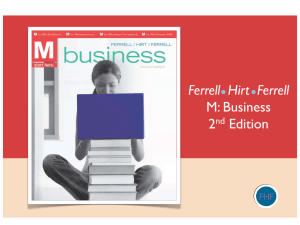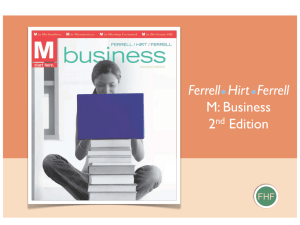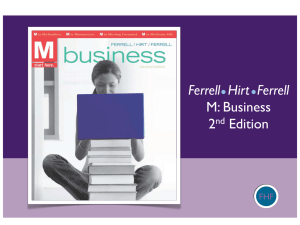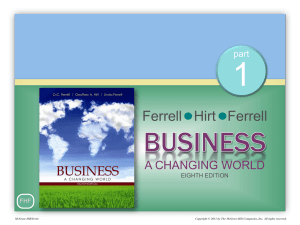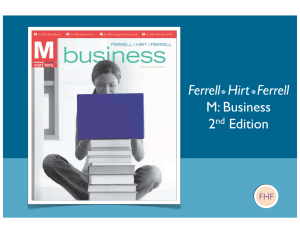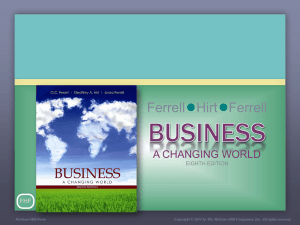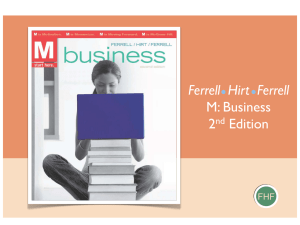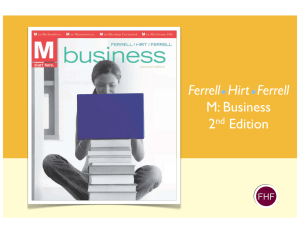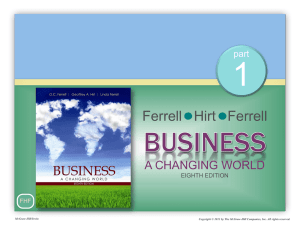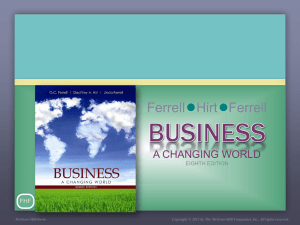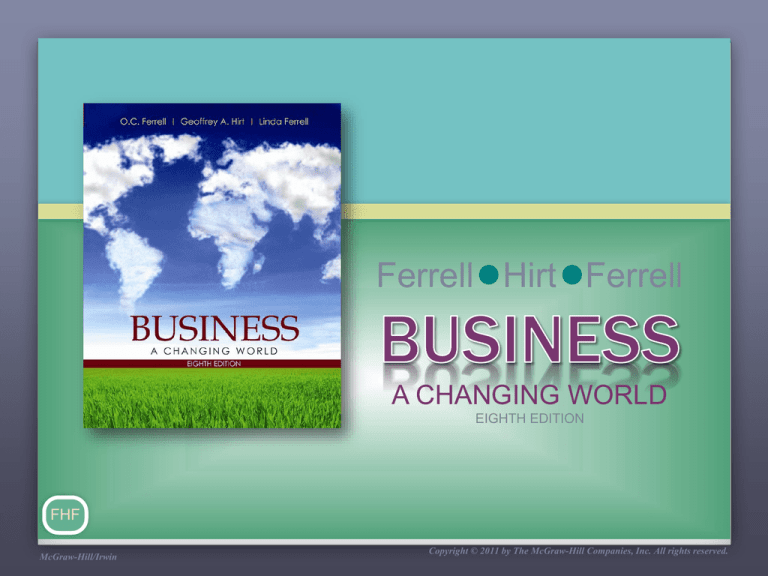
Ferrell Hirt Ferrell
A CHANGING WORLD
EIGHTH EDITION
FHF
McGraw-Hill/Irwin
Copyright © 2011 by The McGraw-Hill Companies, Inc. All rights reserved.
part
Digital Marketing and
Social Networking
5
Chapter 11 Customer-Driven Marketing
Chapter 12 Dimensions of Marketing Strategy
Chapter 13 Digital Marketing and Social Networking
FHF
13-2
What is Digital Marketing?
E-Business
Carrying out the goals of business through use
of the Internet
Digital Media
Electronic media that function using digital codes
Digital Marketing
Using digital media to develop communications and
exchanges with customers
FHF
13-3
Growth and Benefits of
Digital Communication
Digital media has created opportunities for businesses to:
Create relationships with consumers
Target markets more precisely
Reach new markets worldwide
FHF
13-4
Digital Marketing
Has five key characteristics
1. Addressability: The ability for a business to identify
consumers before they make a purchase
2. Interactivity: Allows customers to express their needs and wants
directly to the firm in response to its communications
3. Accessibility: Allows consumers to find information about competing
products, prices, and reviews and to become more informed about a firm
and the relative value of its products
4. Connectivity: Keeps customers and businesses connected with each other
5. Control: Consumers’ ability to regulate the information they receive via
the Internet
FHF
13-5
Using Digital Media in Business
Digital media have created new ways of doing
business and shopping
• Fast communication
• More interactive
• Comparison shopping easier
• Easier to conduct marketing research and advertise
…continued on next page
FHF
13-6
Using Digital Media in Business
Digital media have lowered the cost of
communication and transactions
Digital media are more similar to traditional media
than they are different
Growing problem with controlling employee access to digital
media
• Wasting time at work on personal communications
FHF
13-7
Digital Media and the
Marketing Mix
Some key differences between digital and traditional
media in the marketing mix:
Communications are richer, faster and more interactive
Companies can reach target markets more easily, affordably and quickly
They help marketers utilize new resources in seeking out and
communicating with customers
FHF
13-8
Digital Media and the
Marketing Mix
Digital media let marketers and consumers
share information
Websites
Online social media sites
Email
Listservs
…continued on next page
FHF
13-9
Ways Users Spend Time
on the Internet
Rank
Sector
Global Reach
1
Search
85.9%
2
General Interest Portals
85.2%
3
Software Manufacturers
73.4%
4
Online Communities
66.8%
5
Email
65.1%
Source: Nielson Reports, “Global Faces and Networked Places,” March 2009, p. 3
http://blog.nielsen.com/nielsenwire/wp-content/uploads/2009/03/nielsen_globalfaces_mar09.pdf.
FHF
13-10
Product Considerations
Digital media connectivity creates opportunities
to add services and benefits to products
Some products only available digitally
Internet can make it easier to learn about and anticipate consumer needs
Competition makes quality and service offerings more important than ever
FHF
13-11
Distribution Considerations
The Internet is a new distribution channel
Processing orders electronically can reduce inefficiencies, cost and
redundancies
Can also increase speed
Shipping times and costs are important to customers
FHF
13-12
Promotion Considerations
Promotion is one of the best applications
for digital media
Consumer consumption patterns are changing
•
The products they want to buy
•
The way they get information
Marketers must react and give consumers what they want
FHF
13-13
PepsiCo.’s Online Promotions
Online promotions have made Pepsi
the #1 soda in China
Pepsi holds 23% of soda market in China
Online social media is essential when marketing in China and other
markets with many Internet users
“Pepsi Creative Challenge” was a massive online promotion to celebrate
the 60th anniversary of the People’s Republic
Source: “Pepsi’s Web-Smart Thrust into China,” Businessweek, September 28, 2009.
FHF
13-14
Price Considerations
The most flexible element of the marketing mix
Digital media can enhance a product’s value by providing
service, information, and convenience
• Discounts and sales can be quickly communicated
• Deals websites allow consumers to compare prices of
products
FHF
13-15
Price comparison
Many websites allow consumers to compare prices
to find the best deals
FHF
13-16
Online Social Networks
A web-based meeting place for friends,
family, co-workers and peers that lets users
create a profile and connect with others for
a variety of purposes
Build relationships with customers
Provide product information
Learn about customer needs
Contact new target markets
• Starbucks, Dell, eBay and Google all excel at using social
media for marketing
FHF
13-17
Types of Consumer-Generated
Marketing and Digital Media
Two factors sparked the increase in consumer-generated
information:
1. Increased tendency for consumers to publish their thoughts, opinions and
reviews of products via blogs and other digital media
2. Consumers tend to trust other consumers over corporations
FHF
13-18
Blogs and Wikis
Blogs (Web-Logs)
Web-based journals through which authors can editorialize
and interact with other Internet users
2/3 of Internet users read blogs
Give consumers power over companies because they cannot control what
bloggers write
Wikis
Websites where users can add or edit content of posted articles
Monitoring wiki sites can give corporations ideas about how consumers feel
about their company or products
FHF
13-19
Most Popular Blog
• A liberal conglomeration news website
• Mostly links to stories on other sites
• Launched in 2005 by former conservative commentator
Arianna Huffington
• Over 3,000 bloggers contribute, 60 employees
• Also utilizes vlogging (video blogging)
• More than 28 million visitors a month
FHF
13-20
Video and Photo Sharing
Video Sharing
Lets users upload videos to the Internet
Viral Marketing: Using video sharing and online social
networking sites to spread an advertisement or message about a product
Companies increasingly use consumer-generated content for ads rather than
professional ad agencies
Photo Sharing
Similar to video sharing sites, but allow users to upload, edit and share
photos instead
Businesses use photo sharing to display images of products
FHF
13-21
Podcasting
Podcasts
Audio or video files that can be downloaded form the Internet via a
program that delivers content to listening devices or personal computers
Convenient
Can listen on an Mp3 player or other portable device
Popular with the 18-29 demographic
FHF
13-22
Social Networks
2/3 of consumers have visited online social
networking sites
There are many different sites and the number is growing
• MySpace
• Facebook
• LinkedIn
• Twitter
FHF
13-23
The largest social networking site in the world
Good resource for marketers
Appeals to a broad demographic
Fastest-growing demographic is women over 55
Encourages consumer interaction with companies and
products
Market research
Low-cost means of advertising
Reach new markets
FHF
13-24
A social network for professionals
A profile resembles a résumé
Facilitates professional networking, job searches and recruiting
Companies use the site to familiarize people with their
business
FHF
13-25
Twitter is a hybrid social networking and microblogging site
140 characters or less
Companies announce sales, promotions and product updates
via tweets
Can help (re)build customer relationships
FHF
13-26
Virtual Worlds
Allow users to select an avatar and live out an
alternative life online
• Many virtual worlds allow users to buy and sell goods, services, even
real estate
• Big business: Nearly $300 million on advertising in virtual worlds
annually
FHF
13-27
Virtual Worlds Have a Downside
Although they can be lucrative, some
companies may choose to avoid virtual-worlds and
similar systems
• Negative publicity when gamers claim addiction
• A Hawaii resident sued the creator of virtual-world game Lineage II
• Claimed game rendered him unable to function normally
• Played for 20,000 hours over five years
(or 833 24-hour days)
FHF
13-28
Advertising in Virtual Worlds
Search engine Bing advertised on the social
game
FarmVille and generated 400,000 Facebook fans in
a day
• Users gained virtual currency in FarmVille
by becoming a Bing Facebook fan
• FarmVille is a virtual world farming game
available through Facebook
FHF
13-29
Mobile Marketing
Consumers increasingly do their business and
shopping from mobile devices and smartphones
• Marketers can use digital media to their
advantage
• Requires adapting to new technologies
and consumption patterns
FHF
13-30
More Adults Use Cell Phones as
Primary Phone
Source: USA Today Snapshot, March 7, 2009, A1.
FHF
13-31
What kind of digital technology
user are you?
Creators: Create their own media outlets (e.g. blogs,
podcasts, videos)
Critics: People who comment on blogs or post ratings
and reviews
Collectors: Collect and organize content generated by creators and critics
Joiners: Includes anyone who becomes a user of social networking sites or
other online communities to connect and network
Spectators: Read online information but to not join communities or post
anywhere
Inactives: Do not participate in online digital media; numbers are
dwindling
Developed by Charlene Li and Josh Bernoff of Forrester Research
FHF
13-32
Using Digital Media to
Learn About Consumers
Digital media is a great learning tool
Market research
• Gathering data on consumers
• Asking consumers about preferences
Crowdsourcing involves using communities if interested
consumers to gather input and feedback for marketing
purposes
Can help small businesses on limited budgets compete with
large businesses
FHF
13-33
Legal Issues in Internet
Marketing: Privacy
Shopping on the Internet allows companies
to better track consumers
• Cookies are often used for tracking
Laws and regulations cannot keep up with the rapidlychanging Internet
• Federal Trade Commission considering creating legislation that
limits information companies can gather online
The Better Business Bureau and other organizations can help
organizations develop privacy policies
FHF
13-34
Legal Issues in Internet
Marketing: Identity Theft
Occurs when criminals obtain personal information
that allows them to impersonate someone else in order to
access financial accounts and make purchases
• Security breaches are serious threat to organizations and individuals
• Phishing is using a familiar website to deceive people into divulging
private information
FHF
13-35
Main Sources of Identity Theft
Source: “Consumer Sentinel Network Databook, 2009,” The Federal Trade Commission,
February 3, 2010, p. 3, http://www.ftc.gov/sentinel/reports/sentinel-annual-reports/sentinel-cy2009.pdf
(accessed May 12, 2010).
FHF
13-36
Legal Issues in Internet
Marketing: Online Fraud
Includes any attempt to conduct fraudulent
activities online
Cybercriminals are increasingly using online social
networking sites and other digital media to commit fraud
• They sometimes use social networking sites to pose as charities
and collect donations
Always be careful what information you give out when online;
and used trusted sites whenever possible
FHF
13-37
Legal Issues in Internet Marketing:
Intellectual Property
Intellectual property can include songs, movies,
books, electronics, software, etc.
It is generally protected by patents and copyrights, but these
can be difficult to enforce globally
Piracy and illegal sharing costs global industries billions
annually
90% of illegal software copying is done by businesses
FHF
13-38
Digital Media and how They are
Changing Marketing
Digital media can make your company more
efficient and productive
• Transition to digital media can be challenging
• Correct blend of traditional and digital media in marketing mix takes
time and consideration
• Future marketing opportunities will require a
knowledge of digital media and how to use them
FHF
13-39


